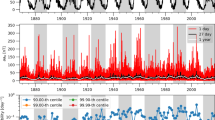Abstract
Results of analysis for improving the space resolution of Earth’s gravity field static models and monthly models by optimizing the orbital parameters (major semiaxis and inclination) of a spacecraft with an onboard gradiometer that is in low-earth orbit are reported. Requirements to the orbits of a spacecraft that will be involved in an advanced gradiometric mission have been worked out. Numerical simulation has made it possible to find the elements of a spacecraft orbit that allow 100% coverage of the Earth’s surface by measurements (subsatellite tracks) with a space resolution of 0.3° × 0.3°. Such a resolution is twice as high and better than that of the Earth’s gravity field static models that were obtained in the GOCE mission data. The orbital configurations found allow construction of monthly models of the Earth’s gravity field with a space resolution of 0.9° × 0.9°, which is four times better than the resolution of models obtained in the GRACE mission. Instrumental requirements to main measuring equipment to be used in a forthcoming space gradiometric mission have been estimated.








Similar content being viewed by others
REFERENCES
R. Pail, S. Bruinsma, F. Migliaccio, et al., J. Geod. 85, 819 (2011).
J. Schall, A. Eicker, and J. Kusche, J. Geod. 88, 403 (2014).
W. Yi, Space Res. 50, 371 (2012).
W. Yi, R. Rummel, and T. Gruber, Stud. Geophys. Geod. 57, 174 (2013).
R. Pail and G. Plank, J. Geod. 76, 462 (2002).
R. Pail, B. Metzler, B. Lackner, et al., in Proceedings of the 3rd International GOCE User Workshop, Frascati, ESRIN, Italy (2006), p. 249.
J. M. Brockmann, N. Zehentner, E. Höck, et al., Geophys. Res. Lett. 41, 8089 (2014).
B. Hofmann-Wellenhor and H. Moritz, Physical Geodesy (Springer, Newfoundland, 2005).
M. van Gelderen and R. Koop, J. Geod. 71, 337 (1997).
W. M. Kaula, Theory of Satellite Geodesy: Applications of Satellites to Geodesy (Dover, Michigan, 2000), p. 160.
B. D. Tapley, S. Bettadpur, M. M. Watkins, et al., Geophys. Res. Lett. 31 (9), 4 (2004).
K. Abich, A. Abramovici, B. Amparan, et al., Phys. Rev. Lett. 123, 031101 (2019).
V. K. Milyukov, A. I. Filetkin, and A. S. Zhamkov, Astron. Rep. 65, 331 (2021).
J. M. Picone, A. E. Hedin, D. P. Drob, et al., J. Geophys. Res.: Space Phys. 107, A12 (2002).
G. Petit and B. Luzum, IERS Technical Note No. 36 (Verlag des Bundesamtsfur Kartographie und Geodasie, Frankfurt-am-Main, 2010), p. 179.
M. V. Belikov and K. A. Taibatorov, Kinem. Fiz. Neb. Tel 6, 24 (1990).
O. Montenbruck and E. Gill, Satellite Orbits. Models, Methods and Applications (Springer, New York, 2000).
V. K. Milyukov and Hsien-Chi Yeh, Astron. Rep. 62, 1003 (2018).
P. Touboul, E. Willemenot, B. Foulon, et al., Boll. Geof. Teor. Appl. 40, 321 (1999).
Jun Luo, Yan-Zheng Bai, Lin Cai, et al., Class. Quantum Grav. 37, 185013 (2020).
P. Bender, A. Brillet, I. Ciufolini, et al., LISA (Laser Interferometer Space Antenna): An International Project in the Field of Fundamental Physics, Space Pre-Phase A Report (Max-Planck-Inst. Quantenoptic, Garching, Germany, 1998).
J. Luo, L.-Sh. Chen, H.-Z. Duan, et al., Class. Quantum Grav. 33, 035010 (2016).
M. Armano, H. Audley, G. Auger, et al., Phys. Rev. Lett. 116, 231101 (2016).
Funding
This investigation was supported by the research–educational school “Fundamental and Applied Investigation of Space” at the Moscow State University and the Russian Foundation for Basic Research (grant no. 19-29-11008).
Author information
Authors and Affiliations
Corresponding author
Additional information
This article was prepared for the special issue dedicated to the centenary of A. E. Chudakov
Translated by V. Isaakyan
Rights and permissions
About this article
Cite this article
Milyukov, V.K., Filetkin, A.I. & Zhamkov, A.S. Spaceborne Gravity Gradiometer: Ways To Improve the Accuracy of Earth’s Gravity Field Models. J. Exp. Theor. Phys. 134, 511–522 (2022). https://doi.org/10.1134/S1063776122040070
Received:
Revised:
Accepted:
Published:
Issue Date:
DOI: https://doi.org/10.1134/S1063776122040070




